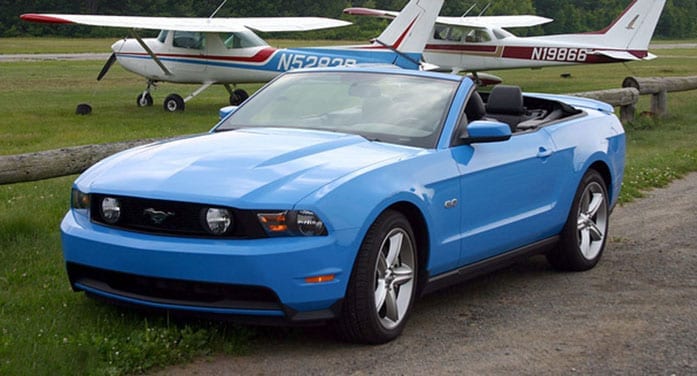 When Ford introduced its Mustang convertible in 1964, it was powered by an optional 260-cubic-inch (4.3-litre) cast-iron V8 engine that developed just over 160 horsepower.
When Ford introduced its Mustang convertible in 1964, it was powered by an optional 260-cubic-inch (4.3-litre) cast-iron V8 engine that developed just over 160 horsepower.
It was later bumped up to 289 cubic inches and more, and Ford went on to sell over a million of the first-generation Mustang in its first year of production.
Forty-seven years later, the Mustang convertible’s base engine was an all-aluminum V6 engine that had smaller displacement yet developed almost twice as much power as the original V8. In 2011, it joined a 5.0-litre V8 and a high-performance Shelby edition. Transmissions were six-speed manual or six-speed automatic.
The V6/manual gearbox combination took the 2011 Mustang convert from zero to 100 km/h in about six seconds. But buyers shouldn’t look for a manual transmission that shifts as smoothly as, say, something from Honda or Nissan; this iteration of the Mustang is still a big, rear-drive American pony car, with a comparatively heavy and stiff shift mechanism.
The convertible featured a lined top with a heated glass rear window, and it deployed in about 15 seconds. A pair of levers must be manually disengaged on the windscreen header and the power button is overhead.
Once the top is down, you understand why some folks wouldn’t be without a convertible. As well as improving all-round visibility, it gives this car a whole new dimension in driveability. Not to mention making parallel parking a whole lot easier compared to the coupe model. But rearward visibility is extremely poor when the top is up.
Equipment level was comparatively decent. Air conditioning, one-touch up-and-down power front windows, tilt steering, speed-sensitive sound system and keyless entry were all standard. And you could order the “interior upgrade” package, which included Sync, satellite radio and a 500-watt sound system.

This iteration of the Mustang is still a big, rear-drive American pony car, with a comparatively heavy and stiff shift mechanism
There are no safety recalls to report from Transport Canada or the U.S. National Highway Traffic Safety Administration (NHTSA). The latter organization, however, had 22 technical service bulletins on file, including problems with unco-operative outside door handles, misfiring and rough idle issues, a range of electrical gremlins – often involving Ford’s MyTouch computer interface – and shifting difficulties in cold weather with the manual gearbox.
A sampling of complaints from owners:
- “Hard to shift until the trans warms up.”
- “The clutch stays engaged and you cannot shift in to any gear while the car is running. Ford has refused to warranty the repairs. Mileage at the time 27,000.”
- “The car began sputtering and then the engine died after pulling off of the interstate. The wrench light flashed and then the check engine light came on and stayed on.”
These last two problem areas – the fuel injection system and transmission – seem to be the most common complaints registered with NHTSA.
Consumer Reports gave the 2011 Mustang its “Good Bet” designation, but there were some flies in the ointment. The transmissions, body hardware and climate control systems were all major problem areas. The expected reliability of this car when new was a paltry two per cent above average.
Some more comments to Consumer Reports from owners:
- “top is easy to operate and double insulated;”
- “if you have to own one be sure and get an extended warranty;”
- “back-up camera is a ‘must have’ and works extremely well;”
- “no telescoping steering wheel – annoying!”
- “rough shifting, hesitation in transmission;”
- “does not handle well in ice and snow;”
- “no problems in one and a half years.”
From a base price of around $32,000 in 2011, the Mustang convertible has dropped to the mid ’teens to low $20,000s these days, depending on the model and equipment level. The V8 versions are running about $5,000 more than the V6, and the Shelby GT500 has become something of a collectible.
2011 Mustang convertible
Original base price: $31,399
Engine: 4.7-litre V6; 5.0-litre V8; 5.4-litre V8
Horsepower/torque: 305/280; 412/390; 550/510
Transmission: Six-speed manual or six-speed automatic
Fuel economy (litres/100 km): 11.1 city and 6.9 highway (V6 with manual transmission), with regular or premium gas
Some alternatives: Volkswagen Eos, Mitsubishi Eclipse Spyder, BMW 135i Cabrio, Chrysler Sebring convertible
Ted Laturnus writes for Troy Media’s Driver Seat Associate website. An automotive journalist since 1976, he has been named Canadian Automobile Journalist of the Year twice and is past-president of the Automobile Journalists Association of Canada (AJAC). For interview requests, click here.
The views, opinions and positions expressed by columnists and contributors are the authors’ alone. They do not inherently or expressly reflect the views, opinions and/or positions of our publication.


